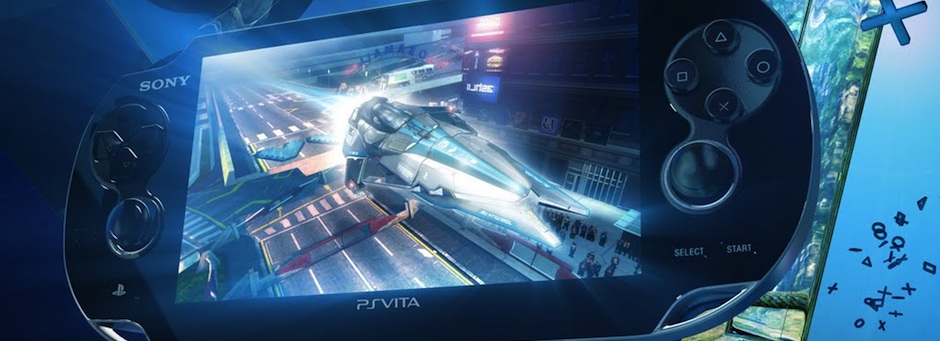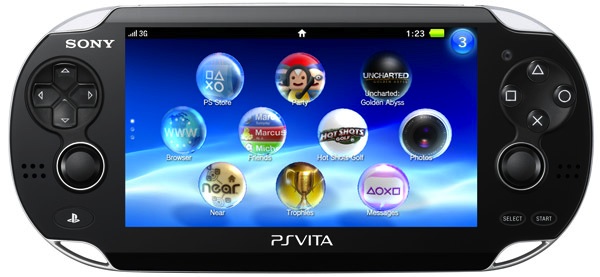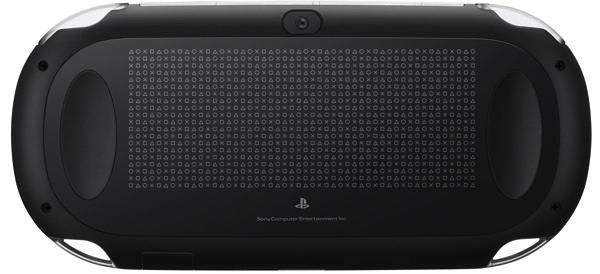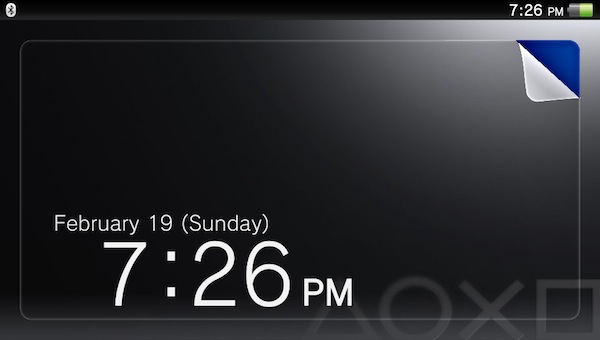I love reviewing new hardware. Especially major launches that we’ve had lately: Kinect, PlayStation Move, as well as the latest big one: Nintendo 3DS. Well, the PlayStation Vita launched officially this week, not including the First Edition Bundles that launched (and sold out across the country) last week, and I’m here to put it through all its paces. Let me start by saying this: new hardware launches are exciting, the start of a new era of gaming, and full of hope and promise, and the PS Vita certainly doesn’t buck the trend.
Technology
Sony has packed everything into this device. The 5-inch screen is absolutely stunning. It obviously has a touchscreen and displays what looks to be HD due to its size, even though it isn’t, but the biggest thing about it is the fact that the screen is in fact OLED. Don’t mind what OLED actually stands for, what it basically means is that it’ll get you the most vivid colours out there, including the blackest blacks you’ll see on a screen until the next miraculous display tech comes along. What the screen actually does is turn off the pixels when black is supposed to be displayed, which not only means they’ll be blacker than black, but you’ll save on battery life in the process.
The touchscreen itself is quite responsive, as you might expect given that it is a capacitive screen, and while it isn’t quite as responsive as the iPhone, it does its job and it does it well. The rear touch pad is a unique innovation that I never thought would make it into the actual product, but without innovation like these, developers can’t come up with unique innovations in their software titles. Massive kudos to Sony for having the cojones to attempt this one, and even bigger kudos to them for actually pulling it off. The rear touch pad is well-tuned and sensitive, albeit in a slightly awkward way, and at this point, it is really up to the developers to really make it shine.
Battery life on the Vita is in a league of its own. Okay, so the battery life is actually right in line with the 3DS, in the three to five hour range. However, considering how much more is going on with the Vita, that in and of itself is exceptional. Through a non-stop run of Uncharted on a freshly charged battery, I hit nearly 5 hours with WiFi and Bluetooth on (though they probably weren’t doing much). Not a bad deal considering the battery life of other devices. I’d be lucky to squeeze five hours out of my iPhone 4 when playing a simple backgammon game, let alone something as graphically intense as Uncharted.
One thing I think the Vita is certainly missing is some semblance of onboard memory. Never before to my knowledge has a game console not come with everything you actually NEED in the box, with the exception of a game, of course. With that said, if you hope to get any use out of your Vita beyond setting up the main operating system, you’ll need to buy one of Sony’s proprietary media cards. Prices for them aren’t ridiculous, per se, but they’re not what we’re used to spending on flash memory. A 4GB card will run you about $20, when you can get the same capacity in an SD card for less than half that. While $20 is a small price to pay, when you’re spending $300 on a game system, it should have at least 512MB worth of memory built-in just so you can do something with it out of the box. This is a bit of a gouge to me, but that’s Sony’s trick sometimes, so play along or, well you won’t be able to.
Proprietary isn’t always a bad thing, though. Other reviews harp on about the proprietary cartridge format that Sony is using for their games. Nintendo hasn’t strayed from the proprietary format concept since the original Game Boy, and their latest handheld continues that trend, so why is Sony getting heat for it? Honestly, I think it is because the design of the cards is so similar to an SD card that people just assume they’re the same. Let up a bit, guys. Everyone else does the proprietary thing for games; Sony can to.
Speaking of these cards, there are of course digital copies of games available in addition to the physical versions, and often at lower prices, so people can avoid physical media altogether if they want to buy a massive 32GB, $100 memory card to go along with it. Trade-offs here and there, sure, but if you don’t want to carry around six game cartridges, maybe that’s your best bet.
Two things that just plain suck on the Vita are the cameras. But again, I think people are harping on about something silly here. I realize the 0.3 megapixels is extremely poor for a device that outshines everything else in every other category, but given the fact that the cameras are just 0.3 megapixels, the pictures look incredible. The sensors Sony is using in the device must be great, because they really do produce some good images considering. Now, you also have to consider how you would use the cameras on the Vita. For professional headshots? No. At your cousin’s wedding? Absolutely not. But for augmented reality games, absolutely. For those, you don’t need anything fancy, so there really is no need to get your megapixels in a knot over the cameras. Certainly not a deal-breaker here.
As a piece of technology, the PlayStation Vita is, without a doubt, the most incredible device I’ve ever used. Strictly as a gaming machine, it has its a few minor flaws, but the pricing on the unit is more than fair, and with this amount of technology and the calibre of developers lining up to make titles for it, the Vita is a beast.
Design
Clearly rooted in Sony’s PSP design language, the Vita is gorgeous. It’s massive but curvy, and while not exactly pocketable (if more for the analog nubs sticking out than its dimensions), is significantly thinner than you might expect for a device packing this much tech. It’s thinner than the 3DS by a slight bit – maybe a few millimetres at most; it feels thinner than the original PSP did, and probably most importantly, its just a comfortable device to hold.
There seems to be an iPhone-inspired design here as well in the edge-to-edge glossy black screen and silver frame running the perimeter of the device. Unlike the iPhone, the Vita is entirely plastic, but it’s certainly solid and doesn’t feel anything like a toy. This is one solid device, although I wouldn’t be complaining if it was a bit heftier in weight had Sony gone with glass and metal for the Vita’s finishes.
The clear shoulder buttons on the device are a clear homage to the original PSP, and they still fit in with the device’s character quite nicely. The L and R labels are etched into the plastic itself rather than being printed below them as with the original PlayStation Portable. It adds another little bit of class that adds to the jazz of the Vita.
The face buttons on the device are perfectly sized, even for my gigantic hands, not because of their diameters, but rather because they’re raised so high. They have a clear separation, unlike the directional pad, so they are easy to jab at. They’re clicker than I would like, but that’s just a minor nitpick, really. If they could be quieter without trading off their responsiveness, it would be great, but I have to say I like the Vita itself better than an actual DualShock 3 controller, so I’m not sure I can pay its buttons more of a compliment.
So let’s face it, you didn’t buy a Vita for the buttons. You bought it for – among other things – the dual analog sticks. Finally, a mainstream handheld with dual analog sticks (Nintendo’s 3DS Circle Pad Pro need not apply), and I will say, these things rock. They’re small, but they work beautifully. Controlling a shooter like Uncharted is no problem whatsoever, and while they don’t have quite the turning radius of a full-size controller, they’re very responsive and get the job done better than I would have expected.
The speakers on the Vita produce incredible sound, both from a high- and mid-range perspective. The bass isn’t the greatest, but connect some headphones and you’re in business. Audio encoding on the Vita is top-notch, so if you’ve got a good set of headphones, you’ll be more than satisfied in this department. I do wish the speaker grilles used tinier holes as these massive things look like they’ll get dirt lodged in them pretty easily, but I think I’m just nitpicking again.
Operating System
The Vita OS is a departure from the XMB (Xross Media Bar) design that originated on the PSP back in 2004. In fact, it’s the first departure from that interface in about eight years, and it’s relatively welcome, save for some, you guessed it, nitpicks. The only real gripe I have with it is the round icons. Not because they’re round, but because the screen can’t render round objects very smoothly, and they come across almost jagged. In all honesty, that’s my only nitpick with the software on the Vita so far.
Even before you see these icons, you’ll have a pretty standard swipe-to-unlock screen. However, this swipe gesture mimics tearing a piece of paper from a notebook from the top right corner down to the bottom left. This gesture is also used to quit running applications, so it is familiar, congruent with the software design, and works without a hitch.
From an operating system standpoint, the Vita has things pretty well wrapped up. I wish they didn’t have so many updates all the time, but in the interest of constant improvement, maybe that’s a good thing. Updates are very quick anyhow, no doubt assisted by the fact that the WiFi protocol Sony chose for the Vita is the latest ‘n’ version for speedy downloads.
To launch a game or an app, you tap on its icon, and then hit the start of continue button. Sony’s version of multitasking has been sorted into what are called “LiveAreas”. Basically, you have a main menu for your application with all related functions (DLC store, information, perhaps an instruction booklet) before you actually launch the app. I hated it at first, thinking “seriously, I have to tap twice to launch a game?”, but it becomes more intuitive when you’ve got a couple of things running and don’t necessarily want to hop right back into one. You can buy a new weapon in a game, for example, while you’re in the middle of it, rather than having to save, quit, buy, and reload the game. It can be pretty intuitive and it works well for the majority of scenarios.
It might seem like an odd addition, but Sony has implemented one of the best versions of Google Maps I’ve seen on any device to date. It’s clean and crisp, and renders very quickly. Realistically, you won’t use them unless a game like Monopoly City Streets portable launches, but I don’t think that is in the cards, unfortunately.
From a game software standpoint, I have to say I don’t think I’ve seen a better launch title lineup in the history of gaming. Sure, there have been some great titles on previous systems from Sony and its competitors, but to have WipEout 2048, ModNation Racers, Hot Shots Golf, and of course, Uncharted: Golden Abyss be the chieftains to reign in a new handheld, Sony has set themselves off to a fantastic start.
Games on the Vita tend to be pretty huge. WipEout 2048 takes up about 1.6GB while Uncharted: Golden Abyss claims a massive 3.2GB for a full game download. This makes total sense considering the games have incredible robust graphics engines, audio production, and just high-quality assets overall, but looking at these numbers puts Vita games almost up to where current generation Xbox 360 games are. It’s just astonishing what is being done with handheld gaming today. Wild.
Being notified that you’ve earned a trophy is clean and consistent on the Vita, even more so than on the PlayStation 3. They’re not drab and grey like their TV console counterpart, but smooth, shaded, and clean. Sony will likely begin to pull an Apple, if you will, and have their mobile features enhance their home console OS. That’s really what every hardware-software company should be doing: designing different features and finding the balance between them for synchronicity across all their platforms. Good work there Sony!
Probably my least favourite choice of Sony’s is for the software titles themselves. Not because they’re not great quality, because they’re incredible, but because in the age of the iPhone, it should be a given that you would have all your games on the go with you, whether they’re physical copies or not. DVDs and Blu-Rays come with digital copies for most releases nowadays, and the Vita should follow suit. It might be easy to say “well, how would Sony combat against people downloading their copy and then giving their physical copy to a friend?”. Simply enough, you could have it tied to a specific console unless there is an internet connection to switch ownership. Better still, you could trust your consumers and not put any restrictions on the content. Sony Pictures does it with their movies, so I’m not sure why it hasn’t transferred over to Sony Computer Entertainment yet, although I do have a sneaking suspicion that it will within the next few months or so.
The Name
I wasn’t a huge fan of “Vita” when I first heard it. In fact, I thought it was crap when it was officially announced at E3. Then again, I hated “Wii” when I first heard it. I even called it a failure based on that factor alone. Well, years have gone by and I love the name now, so much that calling it anything else would just be weird. So ask me about Vita as a name again in a few years, but even in the time since E3 last year, the name has grown on me. Either way, I’m not sure it would help or hurt sales anyway, so if you like the name, great; if not, meh!
The Verdict
I don’t want to say that the PlayStation Vita is a solid effort because that makes it sound like Sony missed the mark with their latest handheld. If I didn’t like it, this review would be far shorter than it is. But I actually love this device. Admittedly, I was more excited about it at E3 than I was here, but seeing the technology in my hand lets me believe that amazing portable things are possible, and it’s really up to the developers to take what Sony has so carefully crafted for them and make amazing things happen.





